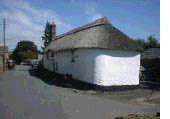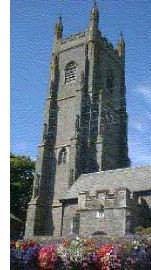 Heritage
Heritage
In the year 815AD Ceolmund,
a 24 year old Saxon Theign, was charged by King Egbert of Wessex to go forth and
settle in the land of the Dumnonii with a royal bride, as reward for distinguished
service in the field of battle. Taking the old Roman roads Ceolmund came upon
the banks of the River Taw. From here he travelled north and finally found a large
open area on top of a hill. The views for miles around were staggering and the
hunting of deer and wild boar in the forests of nearby Eggesford was good. This
was the place he decided to settle, naming it Ceolmund's Leigh, now known as Chulmleigh.
Chulmleigh Parish, as well as being identified by the CPRE as an Area of Rural
Tranquillity is also designated as an Area of Great Landscape Value. It is an
ancient land, unravaged by glaciation with a landscape that sighs and shrugs its
shoulders at the passage of time.
The Celts started clearing trees around Chulmleigh
for their 'nymets' or sacred clearings. The name Nymet or Nympton is widespread
in the area. The Saxons continued their work and built the Devon banks as a means
of marking boundaries.
Devon County Council has produced a Nature Conservation
Strategy for the Chulmleigh area detailing Chulmleigh as having one of the greatest
concentrations of species rich grassland remaining in the world, known as the
Culm grasslands. The largest population of otters in any Natural Area in England
is also to be found.
The old, Saxon hedges and copses are home to the scarce and
declining dormouse, the Barn owl and the rare Brown Hairstreak butterfly while
the grassland is important for the continued survival of the Curlew and the Marsh
Fritillery butterfly.
Ancient semi-natural Woodlands surround Chulmleigh with
a richer and more diverse range of plant and animal life than can be found in
later woodland. Wood Anemones, Wood Sorrel, Pignuts and Wood Spurge can be found
on many tranquil, woodland walks.
Chulmleigh has some very old architecture in
the form of cob and thatch and Devon Stone buildings. Cob is made from natural
clay soil mixed with straw making a breathing, durable structure. The walls need
to be inordinately thick to support the thatched roof. Two of the oldest existing
examples of cob and thatch in Chulmleigh are Egypt Cottage in Egypt Lane and Lower
Dodyard in the rural heart of the Parish. The local Devon stone produces wonderfully
mellow buildings most of which were built by the well off.

 The whole of Chulmleigh Town
centre is now a Conservation Area with many buildings being listed. Walking around
the town you will notice keystones and carved heads above many doors. The 'axe
blade' keystone seems to be a local peculiarity.
The whole of Chulmleigh Town
centre is now a Conservation Area with many buildings being listed. Walking around
the town you will notice keystones and carved heads above many doors. The 'axe
blade' keystone seems to be a local peculiarity.
The Parish Church of St Mary Magdelene is built on a much grander scale than
those in the surrounding villages. Chulmleigh once prospered from the wool industry
and this is likely to have caused the foundation of the Church between 1300 and
1400AD. Inside, the waggon roofs have deeply carved and painted bosses.The glorious
rood screen, stretching the full width of the church, still retains some of its
original colouring.
During the foot and mouth outbreak in 2001 the church was used
for a public meeting, as the Town Hall was too small for the large turn-out of
local people. Addressed from the rood screen by a local farmer in a broad Devon
dialect, the people were exhorted to stand together in the face of adversity.
The atmosphere was electric and harked back to an earlier time was this 2001
or 1646 when Cromwell's army rode through on their way to a famous victory in
nearby Torrington? That is the magic of Chulmleigh, one of the last places where
the 'real' Devon of many centuries is still alive and well.
For those wishing to learn more about the history of the town and surrounding area, theChulmleigh Local History Society hold monthly talks during the winter and regular outings in the summer.

 The whole of Chulmleigh Town
centre is now a Conservation Area with many buildings being listed. Walking around
the town you will notice keystones and carved heads above many doors. The 'axe
blade' keystone seems to be a local peculiarity.
The whole of Chulmleigh Town
centre is now a Conservation Area with many buildings being listed. Walking around
the town you will notice keystones and carved heads above many doors. The 'axe
blade' keystone seems to be a local peculiarity.
 Heritage
Heritage